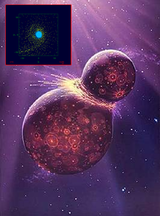The Titan Regional Atmospheric Modeling System (TRAMS)
|

|
- TRAMS is used to understand cloud formation in Titan's lower atmosphere
- Simulations cover regions of a few 100 kilometers
- A parcel of methane-rich air is triggered to rise from the surface
- Once the parcel saturates, methane condenses and the latent heat released continues to drive the parcel upwards at velocities of 10-20 m/s
- Individual cloud particles grow and begin to fall back towards the surface triggering additional cloud formation along the way
- Eventually the entire cloud dissipates through rainout and evaporation
- These storms may produce up to ~1 meter of methane precipitation
|
Origin of the Earth-Moon System
(See also: Center for Lunar Origin and Evolution)
|
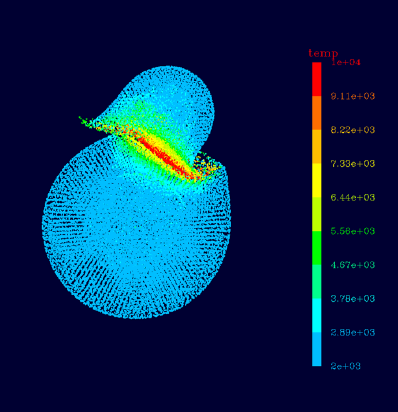
|
- The formation of the Moon from a Mars-sized planetary embryo striking the Proto-Earth is a key topic of research in the dynamics group.
- It involves a synthesis of analytical studies, dynamical models, and smooth particle hydrodynamic (SPH) simulations.
- Key constraints explained include the large size of the Moon, its paucity of iron and volatiles, the large angular momentum of the Earth-Moon system, and their compositional similarity.
|
The "Nice" Model: The Last Stage of Planet Formation
|
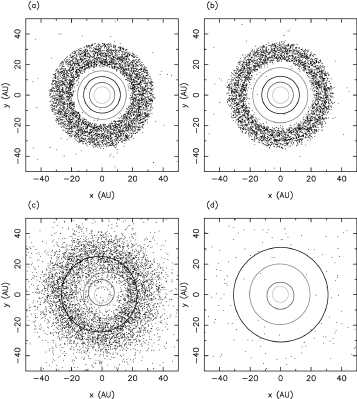
|
- New model of the very last stage of planet formation.
- Jovian planets assumed to form between 5-15 AU.
- Slow planetary migration induced by comets leaking out of 35 Earth mass disk at 16-30 AU.
- After 700 My delay, Jupiter and Saturn cross a mutual resonance.
- This triggers a global instability and leads to a reorganization of the outer solar system.
- Nice model may explain many longstanding dynamical problems (e.g., Jovian planet and Trojan orbits, Lunar Late Heavy Bombardment)
|
Exploring Enceladus' Endogenic Heat
|
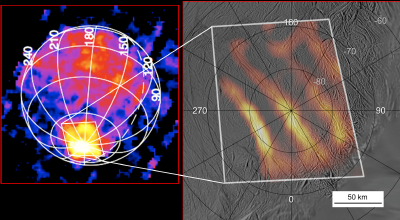
|
- SwRI scientists working with the Composite Infrared Spectrometer (CIRS) instrument on the Cassini Saturn orbiter (in collaboration with CIRS team members from NASA-Goddard) discovered endogenic heat radiation from the south pole of Enceladus in 2005, providing a key piece of evidence that Enceladus is geologically active.
- Investigation is continuing using new CIRS data from eight additional Enceladus flybys by Cassini between 2008 and 2010.
- Research is focusing on determining the total heat flow from Enceladus' interior (roughly 6 GW), which is a strong constraint on models of the active moon's interior and orbital evolution, and constraining the origin of Enceladus' spectacular plumes by determining the distribution of surface temperatures near the plume vents.
|
The MESSENGER Spacecraft Flies by Mercury
|
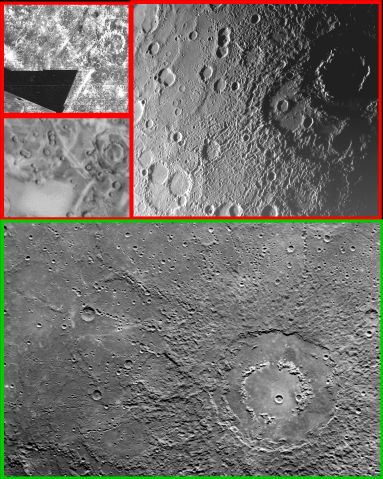
|
- The first of three flybys of Mercury by the MESSENGER spacecraft was on 14 Jan. 2008.
- As shown in the three red-bordered panels to the left, even many parts of Mercury that had been imaged by Mariner 10 in the 1970s (photo-mosaic upper-left; air-brush map lower-left) were revealed much more sharply as MESSENGER approached Mercury (righthand panel).
- Brand new landscapes were revealed as the spacecraft departed. The green-bordered panel shows the very fresh double-ring basin Raditladi with prominent secondary craters.
- At SwRI, Drs. Chapman and Merline have been studying the statistics of impact craters on the new images. Craters were measured within the solid yellow regions of 4 frames of a Narrow Angle Camera mosaic (upper right). The bottom frame shows cratered terrain; above it is a region of secondary craters; above that is a frame showing most of Raditladi; the top frame shows smooth plains.
- Spatial densities of craters as a function of crater diameter are plotted (lower right)
|
Asteroid Breakups and the Probable Source of the K-T Event
|
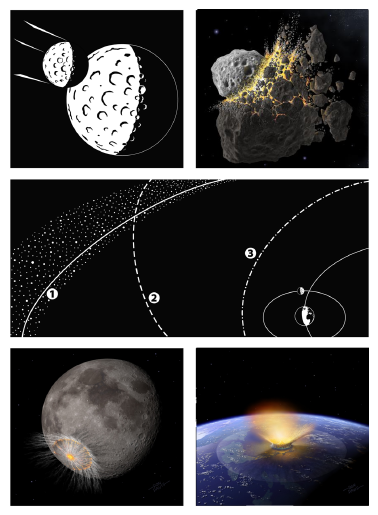
|
- The objects began to slowly migrate in space from Yarkovsky thermal forces.
- The 170 km Baptistina parent body disrupted ~160 My ago in the main asteroid belt and created many fragments.
- Many of the 1-10 km fragments reached a nearby resonance and escaped to the terrestrial planet region. A few hit the Earth and Moon.
- These fragments likely produced the ~65 My old Chicxulub crater on Earth and the ~110 My old Tycho crater on the Moon.
|
The Early Earth
|
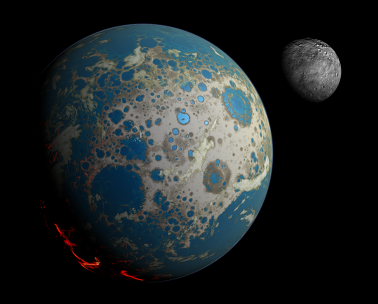
|
- We use current solar system formation models to study the earliest collisional history of the Earth during the so-called Hadean and Archaen eons (ca. 3.5-4.5 billion years ago).
- Collisional models are calibrated against available geochemical data (e.g., elements frequently found bonded with iron) for the Earth and the Moon, as well as lunar crater populations.
- We investigate the effects of early collisions on the system of Earth, including: deep interior response to large scale, impact-induced temperature and pressure fluctuations, excavation and reworking of the uppermost layers, and implications for atmospheric evolution.
|


